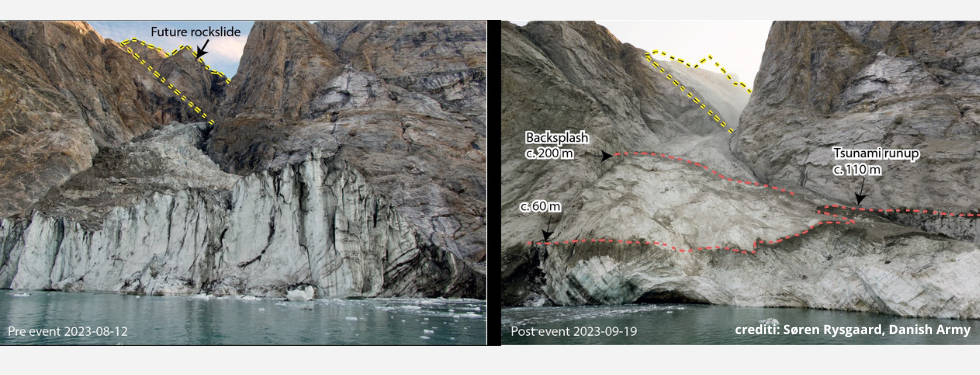In Greenland, a 200m tsunami shook seismometers around the world for nine days

A massive landslide in remote Dickson Fjord in northeast Greenland caused a 200-meter-high mega-tsunami that lasted for nine days. This event resulted in a unique seismic signal that was observed worldwide.
The findings of the study, 'A rockslide-generated tsunami in a Greenland fjord rang the Earth for 9 days', were recently published in the scientific journal 'Science' and involved collaboration among 68 scientists from 40 institutions in 15 countries.
‘When we started this scientific adventure we were all rather puzzled and none of us had the faintest idea what had caused that very peculiar seismic signal: we only knew that it was somehow associated with the landslide,’ says Kristian Svennevig, from the Geological Survey of Denmark and Greenland (GEUS), first author of the paper. ‘This was the first landslide and tsunami due to ice melt observed in East Greenland, showing that climate change is already having a strong impact there as well.’
Various institutions from Italy, including the National Institute of Geophysics and Volcanology (INGV), the University of Catania, and the University of Padua, participated in the research.
‘Our research began in September 2023, when a mysterious 9-day seismic signal was discovered in recordings from seismic stations installed around the world, from the Arctic to Antarctica,’ explains Flavio Cannavò, INGV researcher and co-author of the study. ‘We immediately noticed, however, that the signal appeared completely different from the seismic signals that are recorded in the event of an earthquake: it contained, in fact, a single frequency of vibration, similar to a monotonous-sounding buzzing sound.’
The simultaneous news of a huge tsunami in Dickson Fjord prompted researchers from numerous research institutes and universities around the world to join forces to try to understand if the two events were somehow connected. Through the analysis of seismic and infrasonic data, field measurements, oceanographic sensor network data, live and satellite images, and numerical simulations of tsunami waves, the multidisciplinary team reconstructed the sequence of events triggered by the landslide and tsunami in September of last year.
Piero Poli, a researcher at the Department of Geosciences of the University of Padua, also took part in the study. With the Erc Starting Grant Monifaults project, he detects ‘anomalous’ seismological signals that can shed light on how an earthquake starts.
‘The movement of such a mass of water was able to generate vibrations through the Earth, with seismic waves radiating from the Arctic to Antarctica and generating an anomalous global seismic signal. This event underscores the importance of creating special monitoring systems for seismological data on a global scale that will enable the rapid identification and characterisation of new and increasingly frequent signals associated with surface processes, such as landslides and rapid ice or fluid movements, associated with climate change,’ Poli explains.
Before losing strength, the oscillatory movement lasted nine days. Never before has a seismic wave of such a long duration been recorded, travelling globally and containing only a single frequency of vibration.

PRESS INFORMATION
PAPER: A rockslide-generated tsunami in a Greenland fjord rang Earth for 9 days





